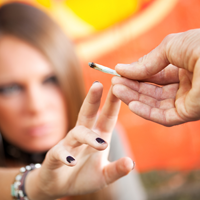Your School Health Profile indicates the number of students at your school who reported using marijuana daily or within the last 12 months, and compares these figures to national results from the 2010-2011 Youth Smoking Survey. Students are also asked whether they think it is easy or difficult to obtain marijuana if they wanted some.
Why is marijuana use a health issue?

Although it is an illegal substance, marijuana is commonly used among Canadian youth1. Its use increases by grade and by grade 12, over one quarter of students will have tried marijuana.2
Marijuana has intoxicating effects including cognitive and psychomotor impairment. Other risks of marijuana use include:
- poor academic performance3
- risky sexual behaviour4
- interpersonal problems/antisocial behaviour4
- respiratory problems5
- dependence and withdrawal6
- acute psychotic symptoms (delusions, confusion, hallucinations)6
- depression and anxiety7
- accidental injury and death.8
Youth who use marijuana are much more likely to use other substances such as tobacco and/or alcohol.1In fact, students who have tried both tobacco and alcohol are 180 times more likely to try marijuana than students that have not tried tobacco or alcohol.1
Marijuana use often co-occurs with poor grades,9,11 negative attitudes about school, school dropout, and lower school satisfaction.10,13 Youth who use marijuana may also be at risk for reduced odds of pursuing post-secondary education or completing a post-secondary degree.12 Early users of marijuana have a significantly higher risk for these negative outcomes.13
If you are concerned about marijuana use at your school, please consult your customized School Health Profile where you can find contact information for local public health professionals.
References
1Leatherdale, S.T., Hammond, D.G., Kaiserman, M., & Ahmed, R. (2007). Marijuana and tobacco use among young adults in Canada: Are they smoking what they think they are smoking? Cancer Causes Control, 18, 391-397.
2Leatherdale, S.T., & Burkhalter, R. (2012). The substance use profile of Canadian youth: Exploring the prevalence of alcohol, drug and tobacco use by gender and grade. Addictive Behaviors, 37, 318-322.
3Leatherdale, S.T., Hammond, D., & Ahmed, R. (2008). Alcohol, marijuana, and tobacco use patterns among youth in Canada. Cancer Causes Control, 19, 361-369.
4Anderson, P. (2006). Global use of alcohol, drugs and tobacco. Drug & Alcohol Review, 25, 489-502.
5Tashkin, D. (1999). Effects of cannabis on the respiratory system. In: Kalant, H., Corrigall, W., Hall, W., & Smart, R. (eds.) The health effect of cannabis, pp. 313-345 (Toronto, Addiction Research Foundation).
6Hall, C. (2000). Cannabis use and public health: Assessing the burden. Addiction, 95(4), 485-490.
7Patton, G.C., Goffey, C., Carlin, J.B., Degenhardt, L., Lynskey, M., & Hall, W. (2002). Cannabis use and mental health in young people: cohort study. British Medical Journal, 325(23), 1195-1198.
8Rehm, J., Taylor, B., & Room, R. (2006). Global burden of disease from alcohol, illicit drugs and tobacco. Drug & Alcohol Review, 25, 503-513.
9Ellickson, P. L., Tucker, J. S., Klein, D. J., & Saner, H. (2004). Antecedents and outcomes of marijuana use initiation during adolescence. Preventive Medicine, 39, 976-984.
10Haller, M., Handley, E., Chassin, L., & Bountress, K. (2010). Developmental cascades: Linking adolescent substance use, affiliation with substance use promoting peers, and academic achievement to adult substance use disorders. Development & Psychopathology, 22, 899-916.
11Henry, K. L. (2010). Academic achievement and adolescent drug use: An examination of reciprocal effects and correlated growth trajectories. Journal of School Health, 80(1), 38-43.
12King, K. M., Meehan, B. T., Trim, R. S., & Chassin, L. (2006). Marker or mediator? The effects of adolescent substance use on young adult educational attainment. Addiction, 101, 1730-1740.
13Lynskey, M., & Hall, W. (2000). The effects of adolescent cannabis use on educational attainment: A review. Addiction, 95(11), 1621-1630.